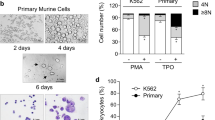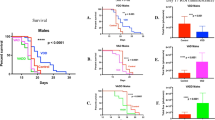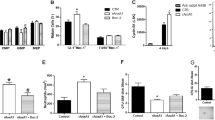Abstract
The ability of the physiologically active form of vitamin D, 1,25-dihydroxyvitamin D3 (1,25(OH)2D3) and two novel vitamin D analogues, EB1089 and KH1060 to induce the differentiation of the U937 and HL-60 leukaemic cell lines was evaluated, alone or in combination with granulocyte–macrophage colony-stimulating factor (GM-CSF). Studies revealed that following 96 h treatment, the vitamin D derivatives inhibited the proliferation, and induced the differentiation of U937 and HL-60 cells in a dose-dependent manner, as determined by cell counts and nitroblue tetrazolium (NBT) reduction assays, respectively. EB1089 and KH1060 were found to be more effective than 1,25(OH)2D3 in exhibiting their antiproliferative and differentiative effects. In contrast, induction of leukaemic cell differentiation with 1 ng/ml GM-CSF after 96 h was less effective when compared with the vitamin D derivatives used individually. Fluorescence activated cell scanning (FACS) analyses indicated that the vitamin D derivatives readily induced the expression of the monocyte-associated cell surface antigen, CD14, and also the β 2-integrins, CD11b and CD18 in both cell lines after 48 h and 96 h treatment. The ability of EB1089 and KH1060 to induce these antigens was achieved with greater efficacy relative to the native hormone. When U937 and HL-60 cell cultures were cotreated for 48 h with the vitamin D compounds and GM-CSF and analysed by FACS, enhanced effects on CD14 and CD11b induction were observed compared to those of the compounds alone. These co-operative effects may occur as a consequence of molecular events which involve the transcription by vitamin D receptors (VDR) of genes required for the responsiveness of immature cells to factors such as GM-CSF, and place these and other related vitamin D analogues as potential therapeutic agents in the treatment of leukaemia.
This is a preview of subscription content, access via your institution
Access options
Subscribe to this journal
Receive 12 print issues and online access
$259.00 per year
only $21.58 per issue
Buy this article
- Purchase on Springer Link
- Instant access to full article PDF
Prices may be subject to local taxes which are calculated during checkout
Similar content being viewed by others
Author information
Authors and Affiliations
Rights and permissions
About this article
Cite this article
James, S., Williams, M., Kelsey, S. et al. Interaction of vitamin D derivatives and granulocyte–macrophage colony-stimulating factor in leukaemic cell differentiation. Leukemia 11, 1017–1025 (1997). https://doi.org/10.1038/sj.leu.2400676
Received:
Accepted:
Issue Date:
DOI: https://doi.org/10.1038/sj.leu.2400676
Keywords
This article is cited by
-
Regulation of monocyte differentiation by specific signaling modules and associated transcription factor networks
Cellular and Molecular Life Sciences (2014)
-
Effects of sodium stibogluconate on differentiation and proliferation of human myeloid leukemia cell lines in vitro
Leukemia (2002)



